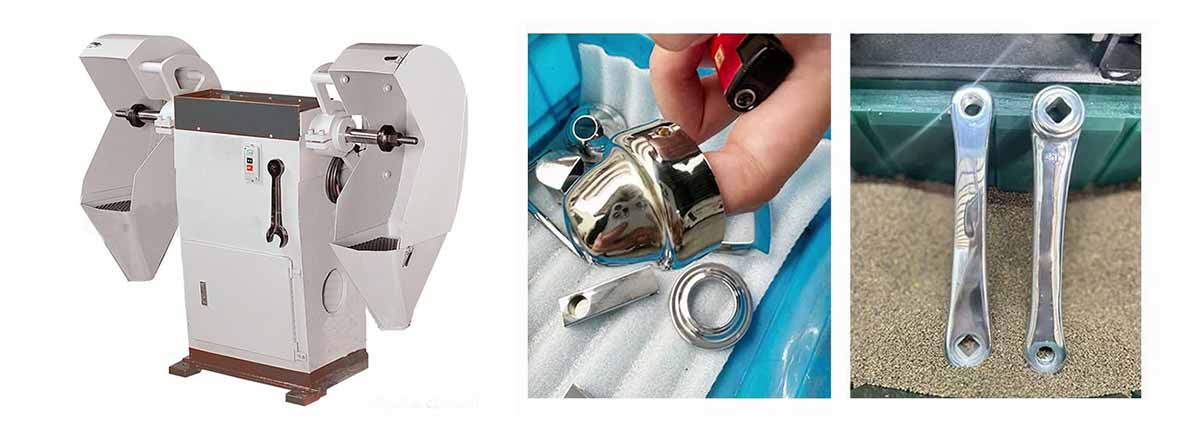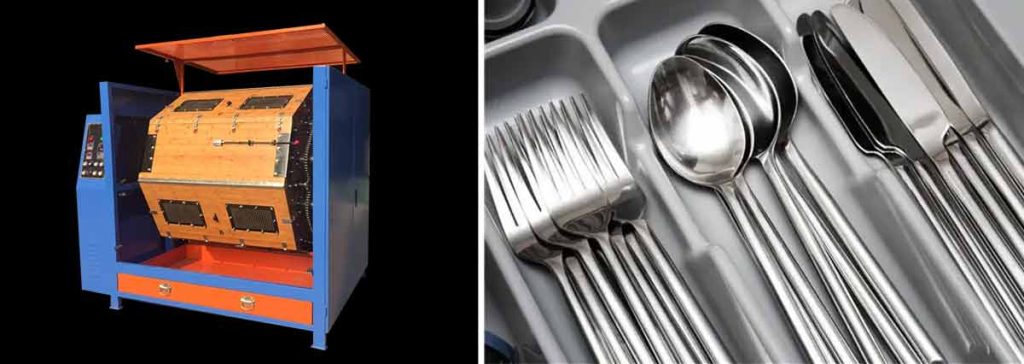

A semi-automatic buffing machine is a specialized tool designed to enhance surface finishing processes. It combines manual control with automated features, offering a balance between precision and efficiency. These semi automatic buffing machines are particularly valuable for medium-sized enterprises, as they improve productivity while maintaining some level of manual intervention. With programmable capabilities and user-friendly interfaces, semi-automatic buffing machines ensure consistent results across various applications. Compared to manual systems, they deliver higher output, while fully automatic buffing machines excel in high-volume production with minimal human error. This versatility makes semi-automatic buffing machine a preferred choice for industries seeking quality and efficiency.
Key Takeaways
- A semi-automatic buffing machine mixes manual work with automation.
- It helps make surface finishing faster and more accurate.
- Main parts include the buffing wheel, motor, and control panel.
- There is also a holder for the item being polished.
- These parts work together to give smooth and good results.
- Safety tools like shields and stop buttons keep workers safe.
- Workers can change settings like speed and pressure easily.
- This helps match the polishing to the material being worked on.
- These machines are useful in many industries and save time.
- They make sure surfaces look great and meet quality rules.
Key Components of a Semi-Automatic Buffing Machine
A semi-automatic buffing machine consists of several essential components that work together to deliver precise and efficient surface finishing. Each part plays a critical role in ensuring the machine operates smoothly and produces consistent results.
Buffing Wheel
The buffing wheel is the heart of any buffing machine. It determines the quality of the finish and the type of material that can be polished. Manufacturers use various materials to create buffing wheels, each suited for specific applications.
| Type of Buffing Wheel | Description | Common Applications |
|---|---|---|
| Loose Buffs | Made of several plies of material, collapses easily for awkward places. | Final buffing prior to plating. |
| Sewn Buffs | Sections of cloth sewn in various patterns, harder and allows more pressure. | Buffing nonferrous metals, coloring buffs. |
| Bias-type Buffs | Cloth cut at a 45-degree angle, combines flexibility and cutting power. | Customizable for various parts. |
| Folded Buffs | Disks of material folded to hold compound, fast cutting and flexible. | Cutting and coloring. |
| Sisal Buffs | Strong cloth, aggressive for polishing and cutting. | Used on ferrous and nonferrous metals. |
| String Buffs | Soft and flexible, avoids buff marks on plastics or precious metals. | Coloring precious metals. |
Semi-automatic buffing machines often use sewn or sisal buffs for their durability and ability to handle various metals. These wheels ensure the machine can polish surfaces effectively, whether for industrial parts or auto buffing machine.
Motor and Drive System
The motor and drive system power the buffing machine. A robust motor ensures the buffing wheel rotates at the required speed for optimal performance. Most semi-automatic buffing machines feature adjustable speed settings, allowing operators to tailor the process to different materials. The drive system connects the motor to the buffing wheel, ensuring smooth and consistent motion. This system is crucial for achieving uniform finishes, especially when polishing intricate surfaces or using a car polishing machine.
Control Panel
The control panel serves as the interface between the operator and the machine. It allows users to set parameters such as speed, pressure, and duration. Modern semi-automatic buffing machines often include digital displays and programmable options, making them user-friendly. Operators can monitor the process in real-time and make adjustments as needed. This feature is particularly beneficial for industries requiring precision, such as automotive manufacturing or fully automatic buffing machine operations.
Workpiece Holder
The workpiece holder secures the item being polished during the buffing process. This component ensures stability and precision, which are essential for achieving consistent surface finishes. Most semi-automatic buffing machines feature adjustable holders to accommodate various shapes and sizes of workpieces. These holders often include clamps or fixtures that grip the material firmly without causing damage.
Operators can adjust the position of the workpiece holder to align the item with the buffing wheel. This flexibility allows the machine to handle diverse applications, from industrial parts to tasks requiring an auto buffing machine. For example, when polishing automotive components, the holder ensures the workpiece remains steady, enabling the buffing wheel to deliver a uniform finish.
Some advanced models include rotary or tilting workpiece holders. These features enhance the machine’s versatility by allowing operators to polish complex surfaces or intricate designs. The workpiece holder plays a critical role in ensuring the buffing process is efficient and produces high-quality results.
Safety Features
Safety features in semi-automatic buffing machines protect operators from potential hazards. These machines often include protective shields around the buffing wheel to prevent debris from flying out during operation. Emergency stop buttons are another common feature, allowing operators to halt the machine instantly in case of an issue.
Operators must wear personal protective equipment (PPE) while using these machines. Safety glasses, goggles, or face shields protect the eyes and face from particles or compounds released during buffing. Leather gloves and heavy aprons are essential when using wire-brush wheels, as these can break off wires that may cause injuries. Fabric gloves should be avoided to prevent accidents caused by entanglement.
Modern semi-automatic buffing machines also incorporate sensors to detect irregularities in the process. These sensors can automatically shut down the machine if they identify a problem, reducing the risk of accidents. By prioritizing safety, these machines ensure operators can work confidently and efficiently, whether using a fully automatic buffing machine or an auto buffing machine for specialized tasks.
How Does a Semi-Automatic Buffing Machine Work?
Loading the Workpiece

The buffing process begins with loading the workpiece into the machine. Operators place the item securely in the workpiece holder, ensuring it aligns with the buffing wheel. Proper alignment is critical for achieving a uniform finish. Adjustable clamps or fixtures hold the material firmly in place, preventing movement during operation. For intricate designs or irregular shapes, operators may use specialized holders to maintain stability.
Semi-automatic buffing machines simplify this step by offering user-friendly mechanisms for loading. Some models include rotary or tilting holders, which allow operators to position the workpiece at precise angles. This feature is especially useful for polishing complex surfaces, such as automotive components or decorative items.
Setting Buffing Parameters
Once the workpiece is loaded, operators set the buffing parameters using the control panel. These parameters include speed, pressure, and duration. Adjusting these settings ensures the machine delivers optimal results for the specific material and finish required. For example, polishing a delicate surface may require lower pressure and speed, while harder metals demand higher settings.
Modern semi-automatic buffing machines often feature digital displays and programmable options. Operators can input precise values or select pre-configured settings for common tasks. This level of customization enhances the machine’s versatility, making it suitable for various applications, from industrial parts to auto detailing buffing machine tasks.
The Buffing Process
The actual buffing process begins once the parameters are set. The motor powers the buffing wheel, which rotates at the designated speed. As the wheel makes contact with the workpiece, it removes imperfections and polishes the surface. Operators monitor the process closely, making adjustments if necessary to ensure consistent results.
Semi-automatic buffing machines combine manual oversight with automated precision. This balance allows operators to intervene when needed while relying on the machine for efficiency. For example, an auto buffing machine used in automotive manufacturing can polish car panels with minimal human effort. Similarly, a car polishing machine may require manual adjustments to achieve a flawless finish.
Throughout the process, safety features protect operators from potential hazards. Protective shields and emergency stop buttons ensure a secure working environment. By the end of the cycle, the workpiece emerges with a smooth, polished surface, ready for further use or assembly.
Monitoring and Adjustments
Operators play a crucial role in monitoring the buffing process to ensure consistent results. They observe the interaction between the buffing wheel and the workpiece, checking for uniformity in the surface finish. Any irregularities, such as uneven polishing or excessive material removal, require immediate attention. Adjustments to speed, pressure, or alignment can correct these issues.
Modern semi-automatic machines simplify this task with real-time feedback systems. Digital displays on the control panel provide data on operational parameters. Operators can use this information to fine-tune the process. For example, if the buffing wheel shows signs of wear, they can replace it promptly to maintain quality.
Some machines, like an auto buffing machine, include sensors that detect anomalies during operation. These sensors alert operators to potential problems, such as overheating or misalignment. By addressing these issues quickly, operators prevent damage to the workpiece and ensure a smooth workflow.
In industries like automotive manufacturing, where precision is critical, monitoring becomes even more important. An auto buffing machine, for instance, requires careful oversight to achieve a flawless finish on car panels. Regular checks and adjustments help maintain the machine’s performance and extend its lifespan.
Unloading The Finished Product

Once the buffing process is complete, operators carefully unload the finished product. The workpiece holder releases the item, allowing it to be removed without damage. Proper handling is essential to preserve the polished surface.
Operators inspect the workpiece for quality assurance before moving it to the next stage of production. They check for a uniform finish, ensuring no imperfections remain. If the results meet the required standards, the product is ready for packaging or assembly.
Semi-automatic machines streamline this step with user-friendly mechanisms. Some models feature automated release systems, reducing manual effort. This feature is particularly useful for handling large or heavy items.
In applications like auto detailing buffing machine tasks, unloading requires extra care. Delicate surfaces, such as car exteriors, demand gentle handling to avoid scratches. Operators often use protective materials, like soft cloths, to safeguard the polished finish.
By following these steps, operators ensure the buffing process delivers high-quality results. Whether using a semi-automatic or fully automatic buffing machine, proper unloading techniques contribute to efficiency and customer satisfaction.
Conclusion
A semi-automatic buffing machine combines manual control with automated precision to deliver efficient and high-quality surface finishing. Its design ensures consistent results by integrating programmable features and user-friendly interfaces. These machines enhance productivity, making them ideal for medium-sized enterprises requiring higher output than manual systems can achieve.
The benefits of using a semi-automatic buffing machine extend beyond efficiency. Its ability to produce consistent results improves car appearance and ensures polished surfaces meet industry standards. Safety features, such as protective shields and emergency stop buttons, further enhance its reliability.
Semi-automatic buffing machines are versatile tools used in industries ranging from automotive manufacturing to decorative item production. Whether polishing intricate designs or achieving an improved car appearance with a car polishing machine, these machines play a vital role in modern manufacturing. Their balance of manual oversight and automated functionality makes them indispensable for achieving consistent results across diverse applications.
